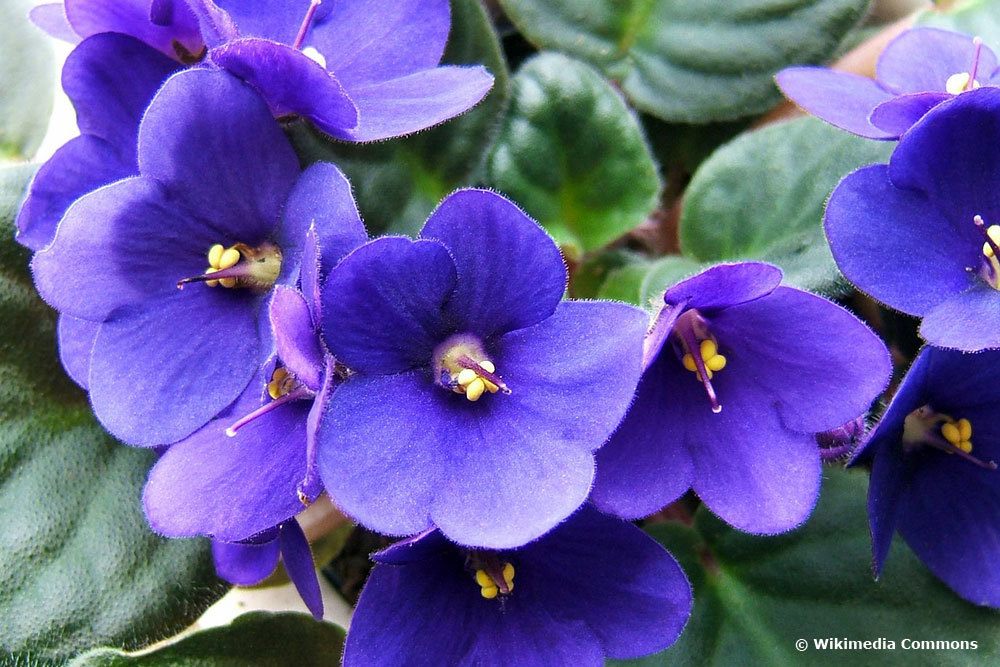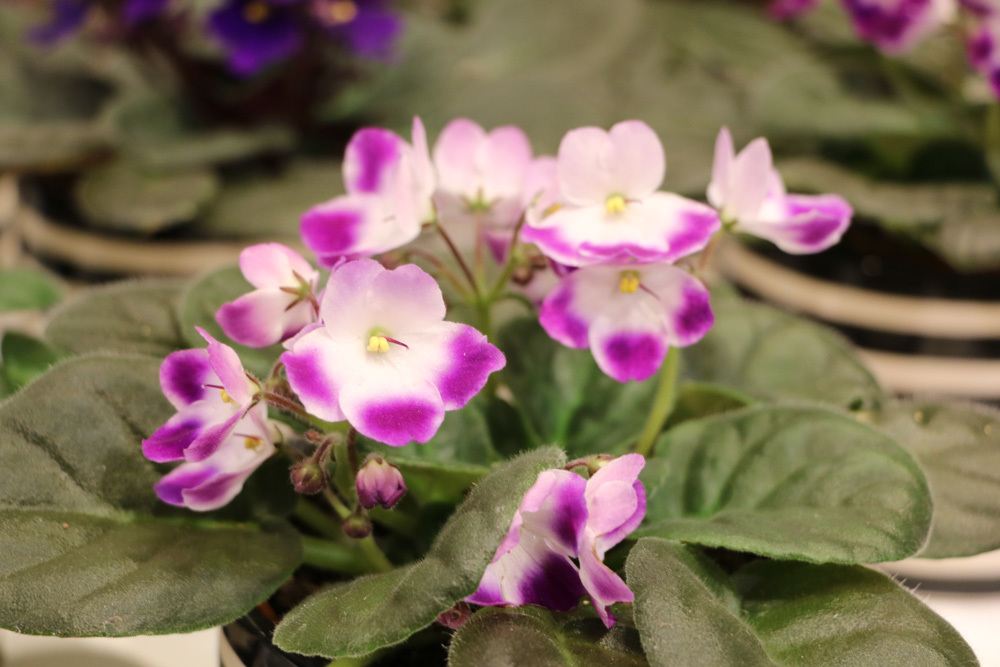Usambara violets have been popular houseplants for decades, as they bloom abundantly. The classic flower colors of the plants are dark purple, white and pink. Today, there are about 2,000 hybrid varieties, so that the choice does not leave any wish unfulfilled. Today, the flower color ranges from white to dark purple, with a wide variety of shades offered. In addition, you can choose between single and double flowers. The height of growth of plants, including flowering, is from 10 to 40 centimeters.
Contents
Best Location To Grow?

Usambara violets in this country should be kept only as houseplants. Even if in summer the temperature outside meets the requirements of the plants, they should not be kept on the balcony or terrace, because they do not tolerate temperature fluctuations. Indoors, they need a location with the following characteristics:
- off-sun to shady
- bright, but without direct sunlight
- ideally a windowsill (west or east side)
- room temperature between 18 and 24 degrees Celsius
- high humidity (e.g. bathroom or kitchen)
- no draught
- no temperature fluctuations
Tip: For the plants to bloom a lot and lushly, you need a location that is bright for at least twelve hours a day.
Substrate
While houseplants are rather demanding when it comes to location, they are rather modest when it comes to substrate. For them, a normal potting soil will do. You will give them a pleasure if you mix it with sand or clay granules.
Buy pregrown potted plants

Usambara violets you can get in the garden center or in specialized stores as pre-potted plants. If you buy the houseplants in winter or at cooler temperatures, then they must be well wrapped for the way home, because they do not like temperatures below 18 degrees Celsius or temperature fluctuations at all.
Repotting guide
Since houseplants do not grow very large, you do not need to repot them very often, as small pots are perfectly sufficient for them. However, they will thank you if they get fresh substrate every year. However, so that the pot does not become too small, you should regularly check whether the plants still have enough space. If the roots are already peeking out of the pot’s drainage hole, you should repot the plants. Another indication that the pot is already completely rooted is small or very closely spaced leaves.
Proceed as follows when repotting:
- ideal time: spring
- Provide a slightly larger pot
- Fill pot with substrate
- Carefully lift Saintpaulia ionantha out of the old one
- Place the plant in the new pot at a distance of about one finger’s width from the top of the pot.
- Leaves or rosette of leaves should rest on the edge of the pot (leaves do not get wet when watering)
- Fill the gaps with soil
Care guide
Plants do not like changes in care, neither room temperature, watering, nor light conditions. Only when fertilizing it is allowed to change the gifts. So you can reduce fertilizing if you want to give the plants a winter break. After all, for lush blooms they need additional nutrients.
Watering
Make sure the substrate is always evenly moist. As with room temperatures, plants do not like fluctuations in water balance. Ideally, water the usambara violet when the top layer of the substrate has dried slightly. Since it does not tolerate lime, ideally you should use rainwater for watering. If this is not possible, then it is best to give it lime-free water. Further, you should note that the watering water is not too cold, because the usambara violet does not like this either. Lukewarm, stagnant water is ideal.
Usambara violets best watered from the bottom. Therefore, they do not get a planter, but a saucer, which facilitates watering. Alternatively, you can lift the plants out of the planter for watering, and place them in a water-filled saucer for watering.
Tip: Usambara violets like warm feet, but they do not like wet feet at all. So waterlogging can even cause the plants to die.
During the watering process, they must not wet leaves of the plants or get wet, because then there is a risk that they will begin to rot. Therefore, despite their high demand for humidity, you should not spray the plants. If the air has too little humidity, for example, above the radiator, then it is best to place a small bowl with water next to the plants. If dust settles on the leaves, then you should not remove it with a damp cloth, but with a brush.
Fertilizing guide
In order for Saintpaulia ionantha to bloom lushly and permanently, it should be fertilized regularly. Ideal is a liquid fertilizer, which you administer about every three weeks. The plants do not need a break from flowering.
Cutting
Usambara violets may not and do not need to be cut. If you find a rotten or dried leaf on the plants, then tear it off with a gentle tug. Under no circumstances should scissors be used. Be careful not to leave any stubs when pulling them off, as these can lead to rot and subsequent death of the plants.
Get it ready for winter
Usambara violets do not need traditional overwintering. It is important that the room temperature does not fall below 18 degrees, even in winter. If you want to give the plants a small (flowering) break, then you should reduce or slowly stop fertilizer applications.
Propagation
Leaf cuttings are suitable for the reproduction of usambara violets. However, for this purpose should use only vigorous plants as mother plants. From the mother plant you can take a leaf for propagation every four weeks, so it will not be damaged by the loss of leaves. However, you should change the mother plant after two years at the latest. If you want to grow only a few new plants, then proceed as follows:
- Tear off the leaf from the mother plant (number of leaves as needed).
- put one leaf at a time into a pot with a mixture of sand and peat
- Put the leaf into the mixture up to the leaf edge
- Keep substrate slightly moist
Tip: Leaf cuttings root best at a temperature between 24 and 27 degrees Celsius. And again, the temperature should not fluctuate.
After about six weeks, small new leaves should have formed next to the leaf you tore off the mother plant.
If you want to grow a whole colony of new usambara violets, then put the individual leaves in a large container. They will then remain there, arranged in rows, until new leaves have formed. Again, this takes about six weeks. Since the container is now too small for the colony, the new leaves are carefully plucked apart and placed in individual pots.
Tip: To ensure that Saintpaulia ionantha develops well, only one young plant goes into each pot.
Propagation in a water glass
When propagating in a water glass, the torn off leaf of the mother plant is placed in a glass with lime-free water. It is important that the edge of the leaf does not come into contact with the water. You should see the first roots after two to three weeks with this type of propagation. If roots have formed, then the young Usambara violets can be transferred to pots (one young plant per pot).
Diseases and pests
If the plants get too much sun, then the leaves become yellow-spotted or yellow-brown. In this case, remove the plants from the sun immediately and give them a shadier spot. Too much water, even if it is well-intentioned, will harm the plants. In the worst case, the roots begin to rot, which eventually leads to the death of the plant.
Save usambara violet is difficult, but you can try to dry it. This means that they transfer it to dry substrate, after you have removed all the rotten roots. If the plants do not get enough water, then the leaves will also change color. In addition, they also turn yellow, if the location does not provide enough humidity for the plants. If almost no flowers form, the usambara violet is too dark or does not get enough nutrients.
Pests
Saintpaulia ionantha is most often attacked by thrips and aphids and mealybugs. If you notice an infestation of these pests, then you should act quickly. But be careful, the delicate leaves do not tolerate spraying with means, even home remedies, against the pests. Therefore, to protect the plants, you should resort to means that you can put or incorporate into the substrate, such as sticks or powder. Likewise, natural predators help against the pests.
Usambara violet has no chance of survival if it is infested with leaf lice (nematodes). This is manifested by glazed and stained leaves. If you notice an infestation, you should remove the plant immediately and dispose of it in the household waste, so that this pest at least does not spread to the other plants.









